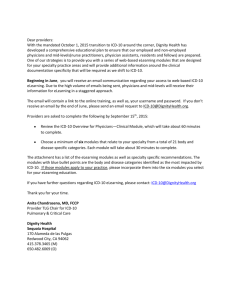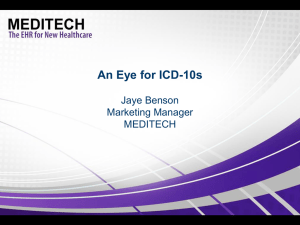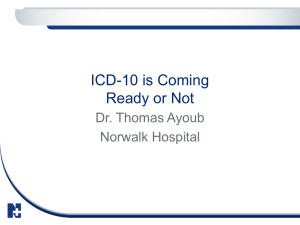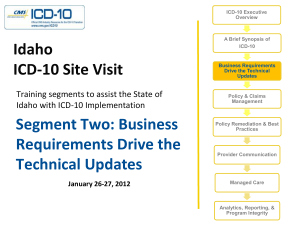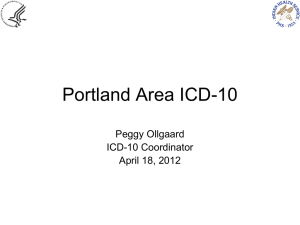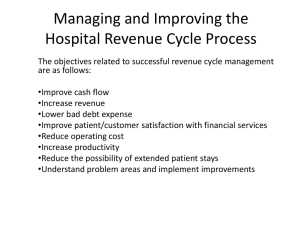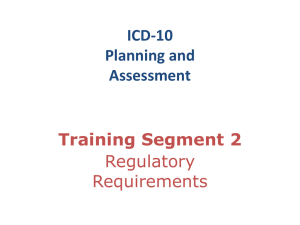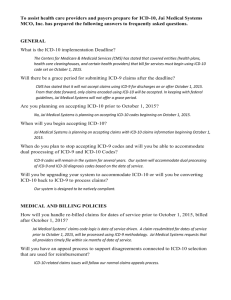ICD-10 Conversion and Quality - California Health Care Safety Net
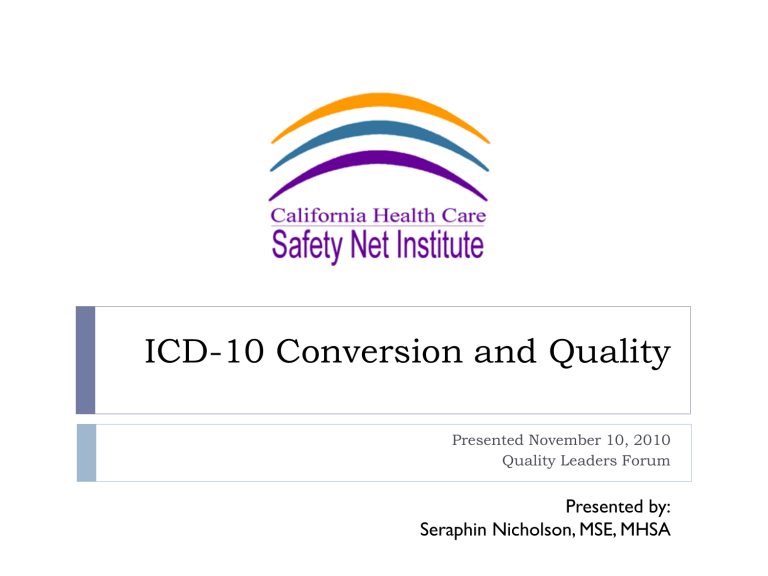
ICD-10 Conversion and Quality
Presented November 10, 2010
Quality Leaders Forum
Presented by:
Seraphin Nicholson, MSE, MHSA
ICD Overview
ICD-9 codes will be replaced
Current codes are 30 years old
Diagnosis coding systems and data structure will change
Federally mandated, conversion must occur by October 2013
ICD-9 is obsolete
Current codes do not reflect current medical knowledge or advances in technology
Is running out of structural capacity
Inhibits the transition to interoperable health data exchange
U.S. is the only industrialized country not using ICD-10 codes
Scope of impact
All healthcare settings and providers
All health plans and payors
All IT solutions using or storing diagnosis and procedure coding
Code Changes
The ICD-10 code set is a full replacement of the ICD-9 code set. This new structure provides additional granularity for diagnosis and inpatient procedure codes and has a different structure:
# of Codes
Total codes
Diagnosis codes
Procedure codes
ICD-9
16,000
13,000
3,000
ICD-10
155,000
68,000
87,000
Structure
Change
Diagnosis
Procedures
ICD-9
.
.
ICD-10
.
.
Code Changes, cont.
This new granularity offers greater specificity for diagnoses and procedures.
For example, under ICD-9, 250.61 is a diabetes mellitus patient, not states as controlled, with Type I neurological complications.
Under ICD-10, this could be coded as:
E10.40 Type I diabetes mellitus with diabetic neuropathy, unspecified
E10.41 Type I diabetes mellitus with diabetic mononeuropathy
E10.44 Type I diabetes mellitus with diabetic amyotrophy
E10.49 Type I diabetes mellitus with other diabetic neurologic complications
Financial Impacts of Code Changes
Hospital revenue may significantly be impacted by code changes
For example:
ICD-9 code 31.99 “Other operations on trachea” currently groups to DRG 168 “Other respiratory systems O.R. procedures w/o cc/mcc” with CMS weight 1.3026 and pays
$6,513
ICD-10 0B717DZ “Dilation of trachea with intraluminal device via natural or artificial opening” will group to MS-DRG v26.0
“Major Chest Procedures w/o cc/mcc” with CMS weight
1.7662 and pays $8,831
Provider & Staff Impact
Provider impact
New framework of thinking about disease states
More details need to be documented in chart
Massive expansion of categories to be familiar with
Hospital-based support personnel
Coders: new scheme, increased information needed to code validly
Finance & billing office: new scheme, payor conversion problems and disparities, overlap during aging of old scheme, new fee schedules and financial models
Health IT: support of new data formats, handling of old data and reports, legacy systems that will not convert
Consequences
Some consequences of ICD-10 conversion include:
Decreased coding productivity
Increased provider queries
Increased delays in reimbursement
Discontinuity in data structures will impact related analytics, trending and associated decision-making
Revenue cycle performance will likely:
Increase in unbilled receivables
Increase in accounts receivables
Slowed and/or reduced cash flows
Long Term Value & Benefit
Public Health
Better disease epidemiology information including signs and symptoms, risk factors and co-morbidities
Research
Better data for mining and improving predictive accuracy
Health Reform
Supports pay for performance
Supports determination of episodes of care and high risk pool patients
Reimbursement
Reimbursement based upon complexity and outcome
ICD-10 & Quality
Improved Quality Measurement
Data availability for quality metrics, patient safety and compliance
Clinically robust pathways can be based upon detailed codes
ICD codes used for measuring quality
HealthGrades, AHRQ, NCQA are just a few of the many organizations that use ICD codes
Increased granularity in ICD-10 codes will help payors and providers more easily identify patients in need of disease management and more effectively tailor disease management programs
ICD-10 & Quality, cont.
Organizational Monitoring and Performance
ICD-10 offers providers and payors better data in support of their efforts to improve performance, create efficiencies and contain costs
RAND believes the coding error rates will be less than what is currently experienced under ICD-9-CM codes because of the improved logic and standardized definitions of ICD-10-PCS and the more accurate clinical terms in ICD-10-CM 1
Increased code specificity will:
Make it easier to compare reported codes with clinical documentation
Check for consistency between diagnosis and procedure codes
Check for illogical combinations of diagnoses
1 RAND Corporation. “The Costs and Benefits of Moving to the ICD-10 Code Sets.”
ICD-10 & Quality, cont.
Replacing ICD-9-CM with ICD-10-CM and ICD-10-PCS will provide higher-quality information for measuring healthcare service quality, safety, and efficacy. This will in turn provide better data for:
Quality measurement and medical error reduction (patient safety)
Outcomes measurement
Clinical research
Clinical, financial, and administrative performance measurement
Health policy planning
Operational and strategic planning and healthcare delivery systems design
Payment systems design and claims processing
Reporting on use and effects of new medical technology
Provider profiling
Refinements to current reimbursement systems, such as severity-adjusted DRG systems
Pay-for-performance programs
Public health and bioterrorism monitoring
Managing care and disease processes
Educating consumers on costs and outcomes of treatment options
ICD-10 & Quality, cont.
Moving to the new code sets will also permit improved efficiencies and lower administrative costs due to replacement of a dysfunctional classification system. This in turn allows:
Increased use of automated tools to facilitate the coding process
Decreased claims submission or claims adjudication costs
Fewer rejected and improper reimbursement claims
Greater interoperability
Decreased need for manual review of health records to meet the information needs of payers, researchers, and other data mining purposes
Decreased need for large research organizations to maintain dual classification systems (one for reimbursement and one for research)
Reduced coding errors
Reduced labor costs and increased productivity
Increased ability to prevent and detect healthcare fraud and abuse
ICD-10 & Quality, cont.
In a 2004 cost/benefit analysis for the Department of
Health and Human Services, the RAND Corporation quantified some of the benefits of improved data derived from ICD-10-CM and ICD-10-PCS. RAND concluded that the benefits far outweigh the costs of implementation, estimating the dollar value of the benefits in the following categories:
More accurate payment for new procedures
Fewer rejected claims
Fewer fraudulent claims
Better understanding of new procedures
Improved disease management 2
2 RAND Corporation. “The Costs and Benefits of Moving to the ICD-10 Code Sets.” March 2004. Available online atwww.rand.org/pubs/technical_reports/2004/RAND_TR132.pdf
Compliance
HIPAA 5010 Transaction Sets
Required to enable transition to ICD-10
Effective date 1/1/2012
Based on transaction date, not date of service
ICD-10
Effective date 10/13/2012
Based on date of service (all OP settings) and discharge date
(all IP settings)
Meaningful Use & ICD-10 Relationship
Must pursue HIPAA 5010/ICD-10 at the same time as
EMR adoption to receive meaningful use incentive payments
Meaningful Use Stage 1 Criteria:
Maintain an up-to-date problem list of current and active diagnoses based on ICD-9-CM or SNOMED CT
The Office of the National Coordinator (ONC) under
HHS has stated that later criteria will require utilizing
ICD-10 or SNOMED CT for problem list documentation.
Bottomline
The rule is final and HHS does not intend to delay the compliance date
Health Reform and ARRA-HITECH legislation both strengthen the need for ICD-10
Meaningful use criteria
Administrative simplification provision in health reform
Noncompliance will jeopardize reimbursements and critical business and clinical operations
Questions?
Seraphin Nicholson snicholson@caph.org
510-874-7221

